- About Ratings
- Research & Insights
- Sectors
- Regulatory
- Products & Benefits
- Events
enJs
Published: June 30, 2021
Forward-looking indicators point to rapidly improving credit trends. The global corporate net negative outlook bias—a measure of future downgrade risk—has continued to decline. It’s now just 14%, down from a high of 37% a year ago, and defaults are trending down from their pandemic peak. Our upwardly revised forecast for global GDP growth of 5.9% this year will help underpin broadly favorable credit conditions.
The pre-pandemic credit cycle is resuming after a pause, but with added leverage for corporates and sovereigns and the share of riskiest credits near an all-time high. Roughly 40% of speculative-grade corporates in the U.S., and more than 30% in Europe, are rated ‘B-’ and lower, leaving some borrowers vulnerable to credit deterioration and defaults if income recovers more slowly than we expect, especially if the cost of debt starts to rise.
Though not our base case, a build-up in inflation is among our top risks. As price pressures build, central banks may be forced to accelerate monetary-policy tightening, which could threaten the orderly normalization of credit conditions. A rapid repricing of risk would hit asset prices, raise the cost of debt, and weigh on funding access—hurting low-rated corporates and some emerging markets.
Vaccine rollouts offer optimism, and countries are becoming better at coping with the economic effects of surges in COVID-19 even during lockdowns. But the picture remains mixed for emerging markets, where the threat of a resurgence in cases (and the consequent drag on the economy) persists even in countries that have improved immunization rates.
Credit trends are improving rapidly, albeit with significant differences across regions and sectors. The primary positive drivers remain intact: rebounding economies, vaccination progress, plentiful liquidity, and a strong appetite for risk even at the weakest end of the credit spectrum. We’ve revised our 2021 global GDP growth forecast up to 5.9% and see upside risks. Crucially, the U.S. and China—which account for almost 40% of the global economy—are both growing rapidly. We expect China’s GDP to grow 8.3% this year, and for the U.S. economy to expand 6.7%, in the biggest jump since 1984. A rapid vaccine rollout in the U.S. has made for a rapid easing of social restrictions, allowing social and economic activity to normalize and reinforcing massive government stimulus programs. Emerging markets, however, remain a concern given that it could take another year to achieve widespread vaccination in those countries. Vaccine-resistant variants remain the primary risk to global normalization, given their potential to undermine even the most successful rollouts and potentially force the reimposition of restrictions.
Reflecting these positive factors, there have been three times as many upgrades as downgrades this year (see chart 1). That said, these upgrades remain a fraction of the total 2020 downgrades triggered by the pandemic and the collapse in oil prices. Companies at the lower end of the scale, in the ‘B’ and ‘CCC’ categories, have accounted for the majority of upgrades (see chart 2). Many of these more vulnerable issuers, which represented the bulk of last year’s downgrades, are benefitting from favorable financing conditions and a better-than-expected economic recovery. Media and entertainment, consumer products, retail and restaurant, and technology are among the sectors that have seen the largest number of upgrades—on the back of the economic rebound, easing of social restrictions, and pick-up in oil prices (see chart 3).
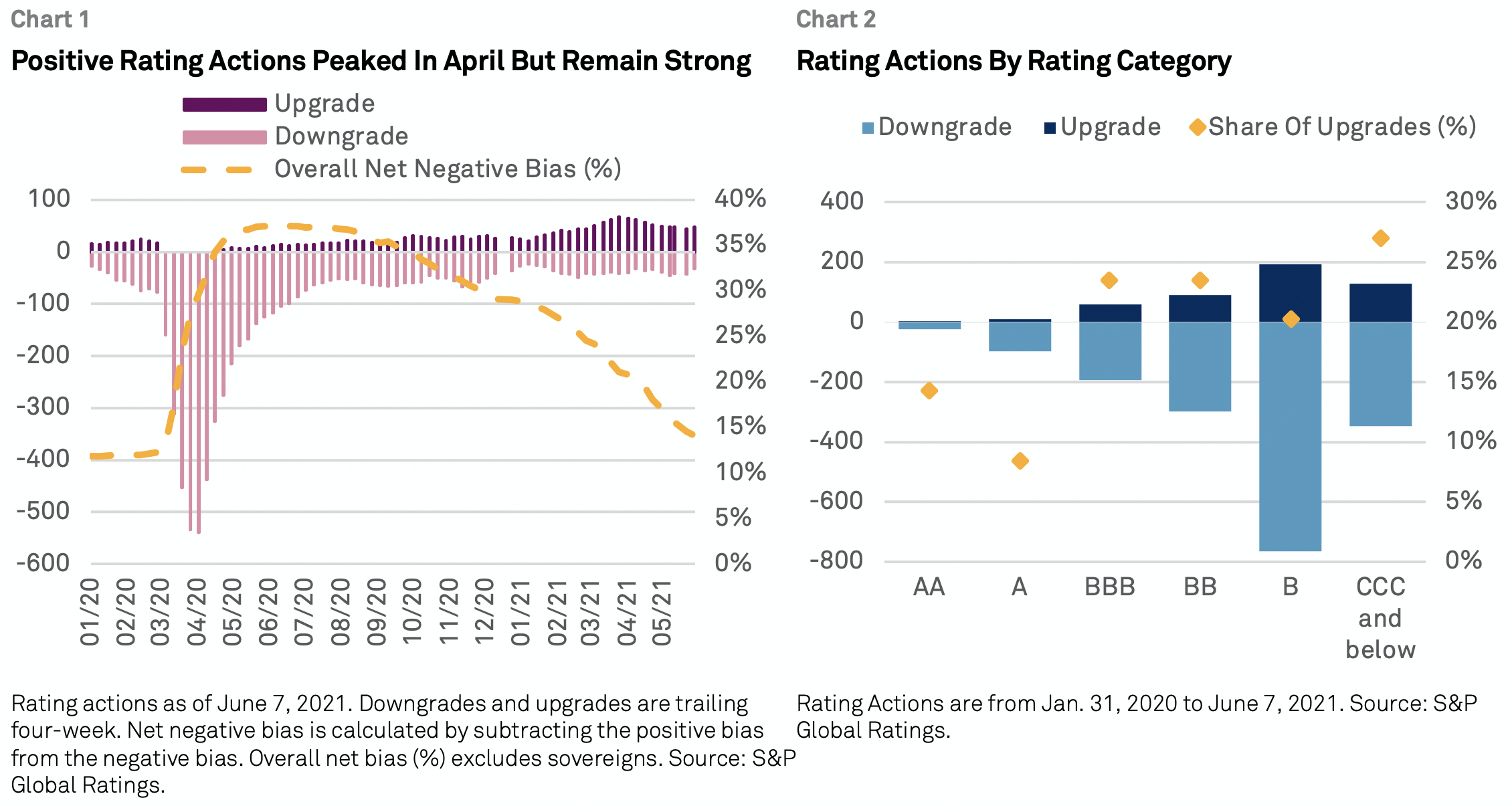
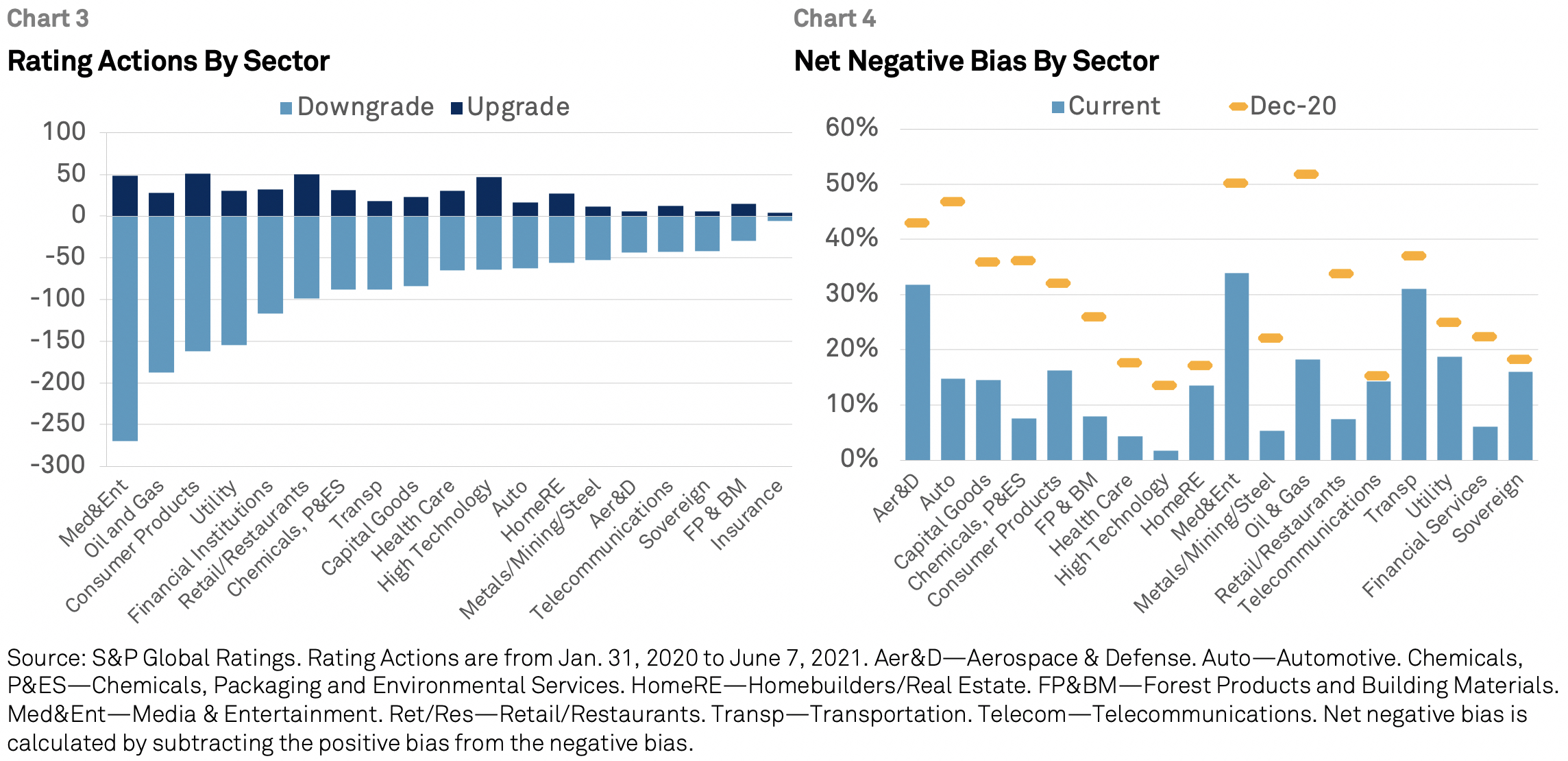
Looking ahead, the net negative outlook bias (indicative of potential rating actions) is now back to pre-pandemic levels at 14%, down from a peak of 37% a year ago, indicating a stabilization of credit quality. While the improved outlook has been most noticeable for the chemicals, oil and gas, automotive, and retail and restaurants sectors, others—such as media and entertainment, and transportation—will likely remain under pressure well into 2022 or later (see chart 4).
Funding conditions remain very supportive, with spreads on corporate debt remarkably tight. Issuers at nearly all ratings levels (as well as in industries where secular headwinds predate the pandemic) have been able to tap the capital markets at welcoming terms. Secondary-market spreads are narrower than they were before the pandemic, and the compression in ‘B’ and ‘CCC’ category spreads illustrates the huge appetite among investors for riskier assets (see charts 5 and 6). The economic recovery and stability in financial markets have brought our estimated spreads closer to observed spreads—after market pricing of risk during the pandemic remained consistently more optimistic than economic and financial indicators suggested.
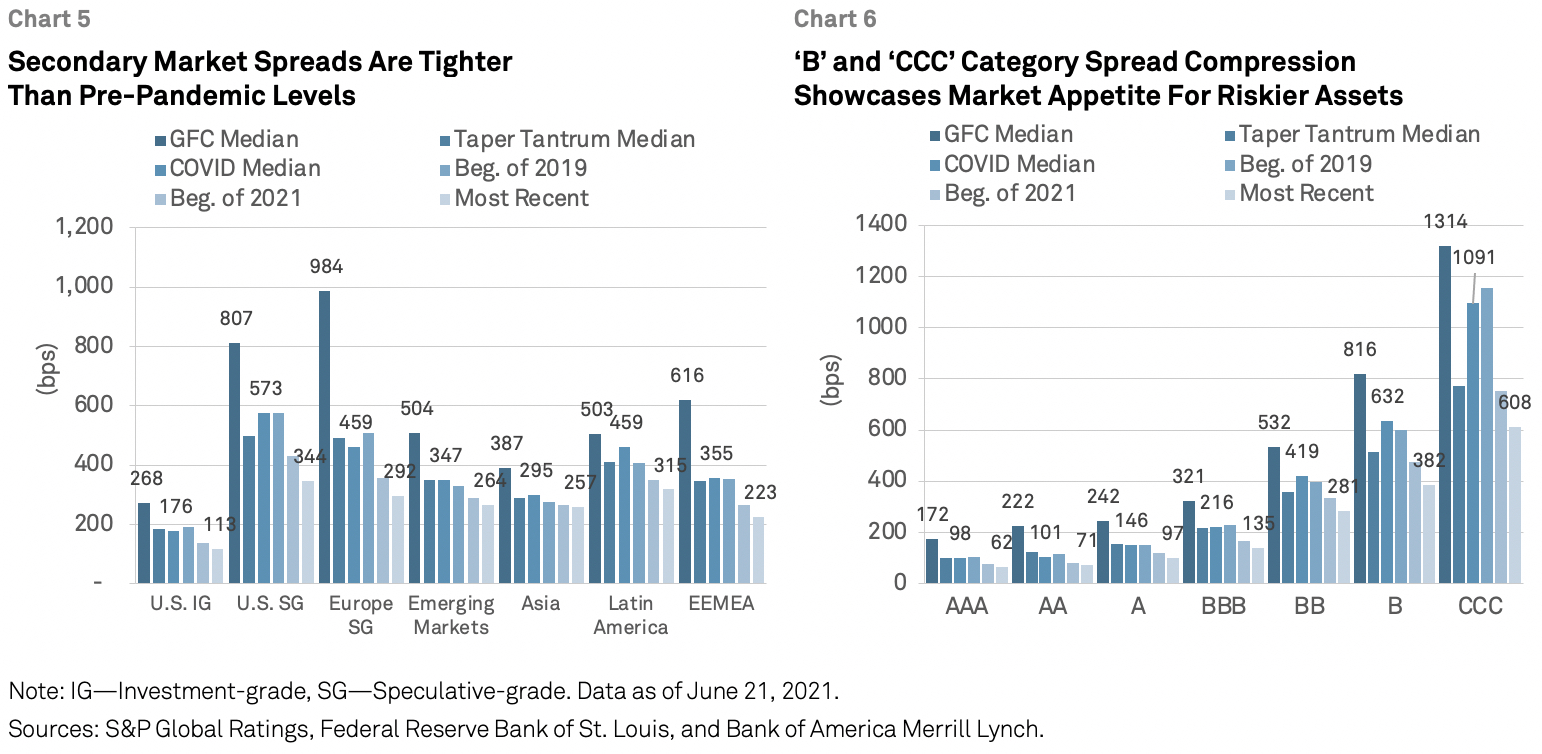
This is not a new credit cycle, but rather a resumption of the pre-pandemic one, characterized by borrower-friendly deal terms and the hunt for yield. Speculative-grade issuance in the U.S. and Europe has soared to new year-to-date highs. Combined spec-grade bond and leveraged-loan issuance through May topped $536 billion in the U.S. and €160 billion in Europe—about 3-4 months ahead of the typical annual pace. With much of the issuance used to refinance and extend maturities, borrowers in both regions are on more-solid footing to weather any inflation/interest-rate risks. But U.S. speculative-grade corporate real bond yields have fallen below zero, which raises questions about whether prospective returns adequately compensate for credit risk.
Beyond the evolving health crisis, the top risks we are watching include the potential for a sustained upturn in inflation, rapid market repricing, and new highs in global leverage.
Our base case is that the surge in inflation will be transitory, given that many of the prices now soaring are rebounding from pandemic lows or distortions and are unlikely to continue rising at the current pace. We expect supply-chain constraints and labor imbalances will slowly ease in the second half of the year, helping central banks keep policy rates unchanged until the first quarter of 2023 for the U.S. Federal Reserve and late 2024 for the European Central Bank (ECB). Emerging market central banks face a more difficult challenge, with some already having to raise rates, notably Russia, Brazil, and Mexico. However, it’s our view that the central banks that most affect global financing conditions—particularly the Fed and the ECB—have the tools to subdue inflationary pressures and are unlikely to have to raise rates substantially in the medium term. The greater challenges lie in managing market expectations and timing policy shifts in a way that doesn’t choke of recovery too soon or allow inflation expectations to build to a degree that requires higher interest rates to control.
Inflation remains a key risk to our base case, as a build-up in inflationary pressure could hit credit in multiple ways. In a sensitivity analysis on more than 10,000 corporates (equivalent to about 31% of estimated corporate debt, both rated and unrated), we estimated that a twin shock of 1970s-style cost inflation and spreads at the levels of the Global Financial Crisis (GFC) could almost double potential defaulters, to 12%, by 2023 (see “Global Debt Leverage: Spreads, Costs Shock May Double Rate Of Loss-Making,” published June 22). The share of “highly indebted” companies could reach almost 40%. But for most, their pushing out of debt maturities in recent years has cushioned them against interest-cost rises—at least for now. Over time, rate rises would increasingly weigh on debt sustainability as more debt comes due. Cost inflation is more worrying for most, as many may not be able to pass on input-cost increases to customers.
Inflationary pressures could also make it difficult for central banks to normalize credit conditions without triggering excessive market volatility. They may be forced to tighten monetary policy sooner than they’d like, potentially triggering financial market volatility and a sharp market repricing akin to 2013’s so-called “taper tantrum.” A rapid and volatile market repricing—affecting financial and real asset prices, debt-servicing costs, and funding access—would hurt lower-rated corporates and some emerging markets. The EMs most reliant on external financing are vulnerable to volatile capital flows and fragile investor sentiment, while those with material foreign-currency borrowings could suffer from an appreciation in the U.S. dollar.
Our base case is for default rates to fall further from their pandemic peak, as the economic recovery drives additional improvements in credit quality, and fiscal and monetary policy remain supportive and unlikely to be derailed by inflation. We now forecast the U.S. trailing-12-month speculative-grade corporate default rate to decline to 4% by March 2022, from 6.3% in March of this year (see chart 7). The outlook is similar in Europe, where we forecast the default rate to fall to 5.25% from 6.1% in March.
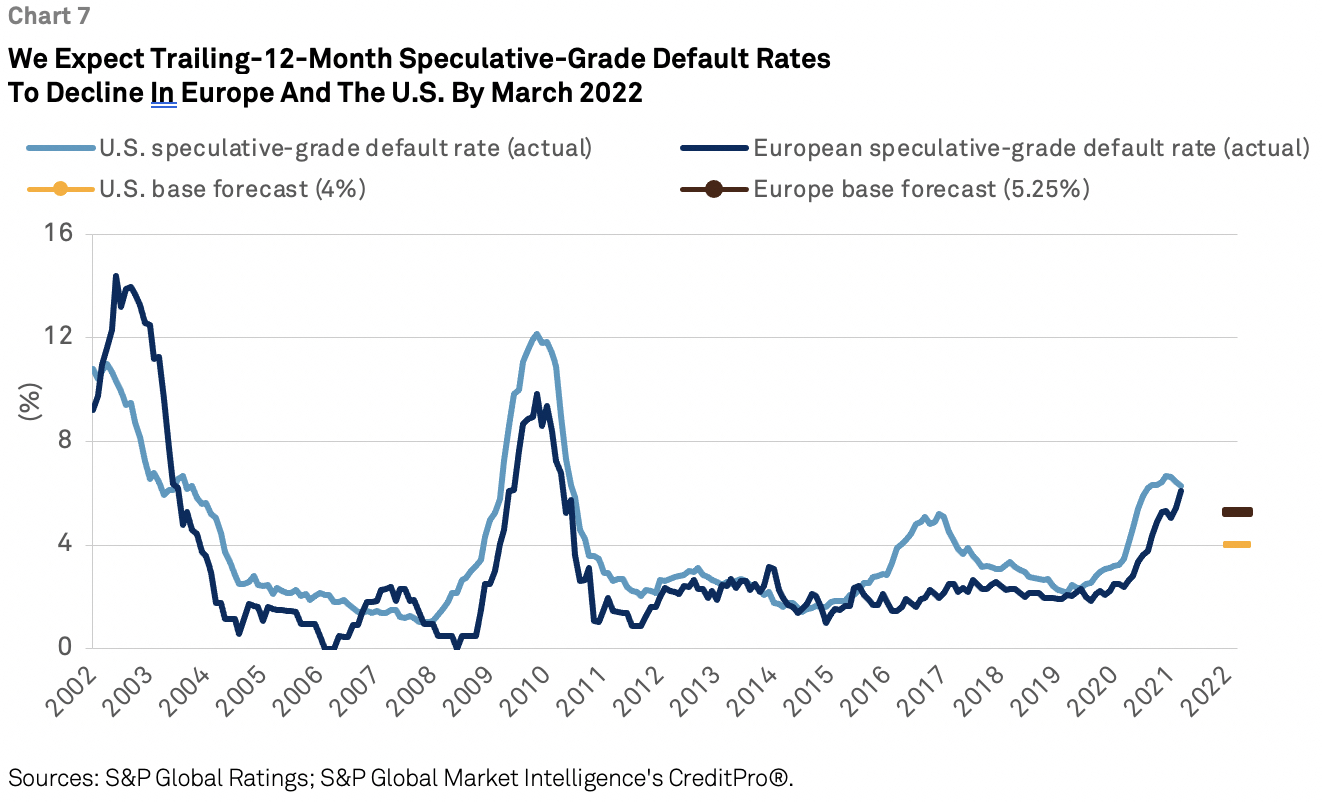
Increased market exposure to weaker credits is one potential risk to this view. Continuing a pre-pandemic trend, the proportion of riskier corporate credits reached new highs with 40% of spec-grade issuers rated ‘B-’ and below in the U.S. and 33% in Europe. Although liquidity has allowed many borrowers to reset themselves to cope with the strains of the pandemic, it could take years for some sectors to recover their pre-pandemic credit metrics. The weakest credits will remain highly vulnerable to any unforeseen market or economic shocks.
Record-high debt could make for a drawn-out default cycle. Both sovereigns and corporates have taken on substantial amounts of debt to survive or help the broader economy survive the pandemic. A resumption of economic growth and profitability will be critical to help alleviate these debt burdens, with a positive feedback cycle of higher profits boosting tax receipts and limiting the need for tax increases. If the recovery proves slower than hoped, default risks might rise sharply again, and the cost of the pandemic could rise.
As extraordinary stimulus recedes, credit pressures will continue to build on corporates in industries that we expect won’t fully recover earnings before next year or later. This could keep default rates above average for longer, fuel credit losses at banks, and weigh on investments and long-term growth. For sovereigns, the impact of high debt on credit quality will depend on the effectiveness policies to restore growth, fiscal and monetary flexibility, and exposure to shifts in market conditions.
The pace of recovery from COVID-19 continues to vary widely by industry. Some sectors—e.g., telecoms, tech, and utilities—have been relatively unscathed by the pandemic, and others—such as capital goods—have recovered rapidly. But we think it will take until well into next year, at least, for many to recover to pre-pandemic credit metrics (see "COVID-19 Heat Map: Pent-Up Demand And Supply Shortages Further Improve Recovery Prospects For Credit Quality,” published June 8).
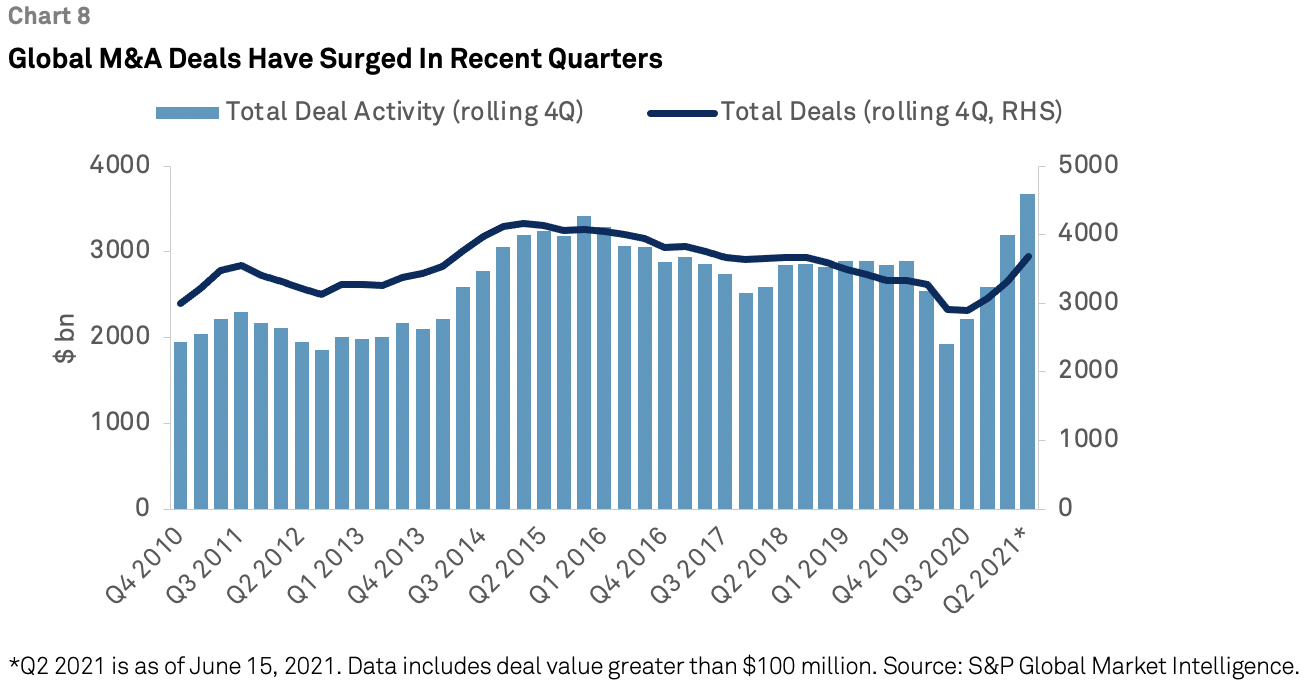
With many industries not returning to the pre-COVID world, capex, and M&A are likely to surge. Shifts in consumer and corporate behavior triggered—or accelerated—by the pandemic will likely have sustained effects that require a repositioning of business models. Capital expenditures (capex) and mergers and acquisition (M&A) activity are the two primary routes to adjusting these, and we expect substantial use of both routes. We expect global nonfinancial corporate capex to increase 12% this year, its fastest pace since 2007. Similarly, global M&A exceeded $1 trillion in the fourth quarter of last year and January-March of 2021, and we expect deal activity to remain high (see chart 8).
Economic recovery and ample liquidity have bought time, but leverage and solvency risks remain. Balance-sheet cash remains plentiful to finance investments, and private equity also has substantial capacity to acquire or reshape businesses. However, execution risk is always significant and is heightened by the uncertainties of when we will reach a post-COVID world and what form it takes. While corporates in aggregate have plentiful cash, they also have higher leverage. Moreover, much of this cash is often concentrated in the hands of investment-grade issuers in sectors seeking to be disruptors (technology), cope with disruptors (retail, autos), or deal with climate transition (utilities). Consequently, financial returns on investment could be low. The dash for cash through the pandemic was more elemental for speculative-grade issuers and, with leverage elevated, the risks posed by a stalled recovery or irrevocable industry changes are all the greater and, arguably, not fully reflected in current yields.
In the U.S., regulations implemented since the GFC—related to banks’ capital and liquidity, underwriting, operational risk, and governance—have bolstered their resilience. Most banks were displaying good financial performance prior to the COVID-19 shock, and the pandemic’s hit to credit losses and earnings has been less severe than we first thought. As a result, we may revise the anchor—or starting point—for our ratings on U.S. banks to ‘A-’ from ‘BBB+’ in the next 1-2 years, if the stringency of regulation remains in place, the economy continues to grow and reflation is orderly, and banks maintain strong balance sheets and good asset quality. A higher anchor would lead us to raise our ratings on a number of U.S. banks that now have positive outlooks.
In Europe, the effectiveness of government support and the strength of the economic rebound are benefitting banks by curbing the expected asset-quality deterioration. We remain mindful that we have yet to see the full effect of the pandemic on banks’ asset quality. Nevertheless, we think the vast majority of European banks will report improved profits this year, aided by lower credit-impairment charges, and gradually improving fee and commission income. But the threat of longer-term challenges persists, whether from a yield curve that remains quite flat in the euro area in particular, overbanked markets affecting risk-based pricing, and the battle to digitize.
In Asia-Pacific, slow vaccinations in some jurisdictions could constrain the economic recovery, which could cause rigidity in banks’ credit losses. But even as relief measures are withdrawn, and with the noteworthy exception of China, we expect credit losses to decline in most major Asia-Pacific banking jurisdictions in 2021 and 2022. We expect that many systemically important banks would be beneficiaries of extraordinary government support in the unlikely event it’s needed.
Many EMs remain far behind in vaccine availability and distribution and continue to suffer the economic drag of social restrictions to prevent the spread of the pandemic. New strains of the disease continue to surface, and the vaccines in use in many EM countries have proven less effective, posing additional threats. But the economic recovery means that pressures on sovereign ratings—while still tilted to the negative—are showing signs of a gradual stabilization.
Countries’ uneven emergence from the crisis means government fiscal and monetary support is still needed and poses another risk: the resurgence of inflation and its subsequent upward pressures on interest rates coming from developed markets where economic activity is fast resuming. This could hit sovereigns reliant on foreign funding to meet their financing needs. It could also weigh on the debt-servicing capacity of governments that have piled on debt in the past year.
Along these lines, a scenario in which the U.S. is “too far” ahead of the rest of the world could become problematic. The Fed’s policy rate could rise faster than is warranted by global macroeconomic conditions. And higher yields on U.S. Treasuries (which have been fairly steady so far) could raise borrowing costs for a host of countries and entities. Because global capital flows chase yields and growth, this would push investment to the U.S. and away from EMs, in particular.
A third key risk for EM sovereign ratings revolves around the social impact of the pandemic, which could reverberate for years. Social tensions, already high before COVID-19, have been amplified and could constrain policy makers as they unwind fiscal and monetary support.
In the longer-term, cyber-risks continue to pose a systemic threat and significant single-entity risk—especially as new targets and methods are emerging. As public and private organizations are forced to accelerate their digital transformation, we believe those that employ a combination of risk-management actions, both before and after an attack, followed by swift remediation, are best-positioned to face this threat. By contrast, entities lacking well-tested playbooks to shape their responses are most vulnerable.
Another secular risk is related to environmental, social, and governance (ESG) concerns—Amid increased global awareness on climate change and recognition of the need to move to a carbon-neutral economy, the focus on energy transition is likely to accelerate regulatory changes, disrupt some operating models, and weigh on funding access for carbon-intensive industries. As investors and policymakers intensify their focus on ESG factors, borrowers that are (or are perceived as being) ESG-noncompliant could face increasing policy risks or limited access to capital—with restrictions ranging from having to pay a premium to borrow to being shut out of capital markets.
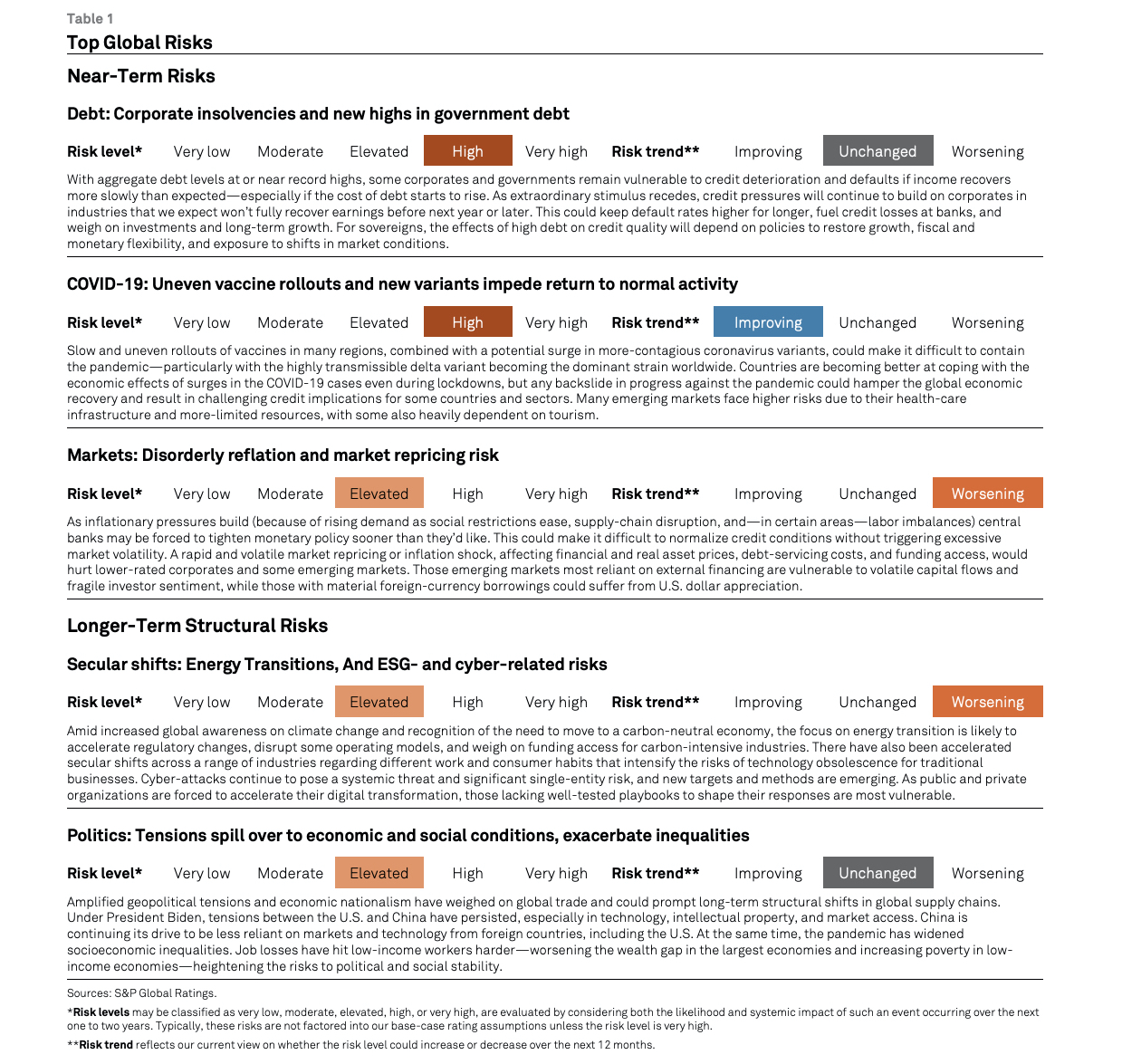
Credit Conditions
Economic Outlook
Research